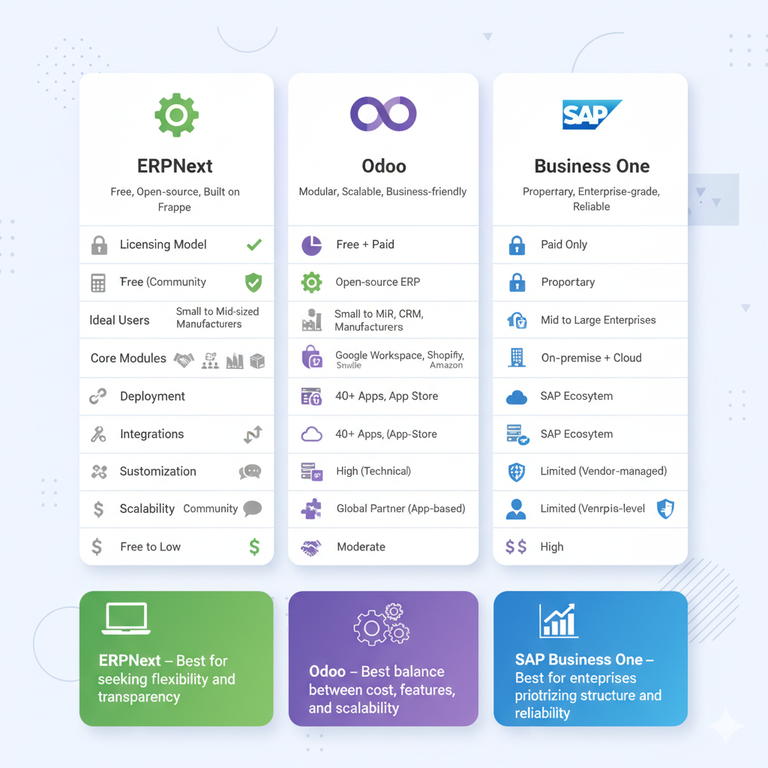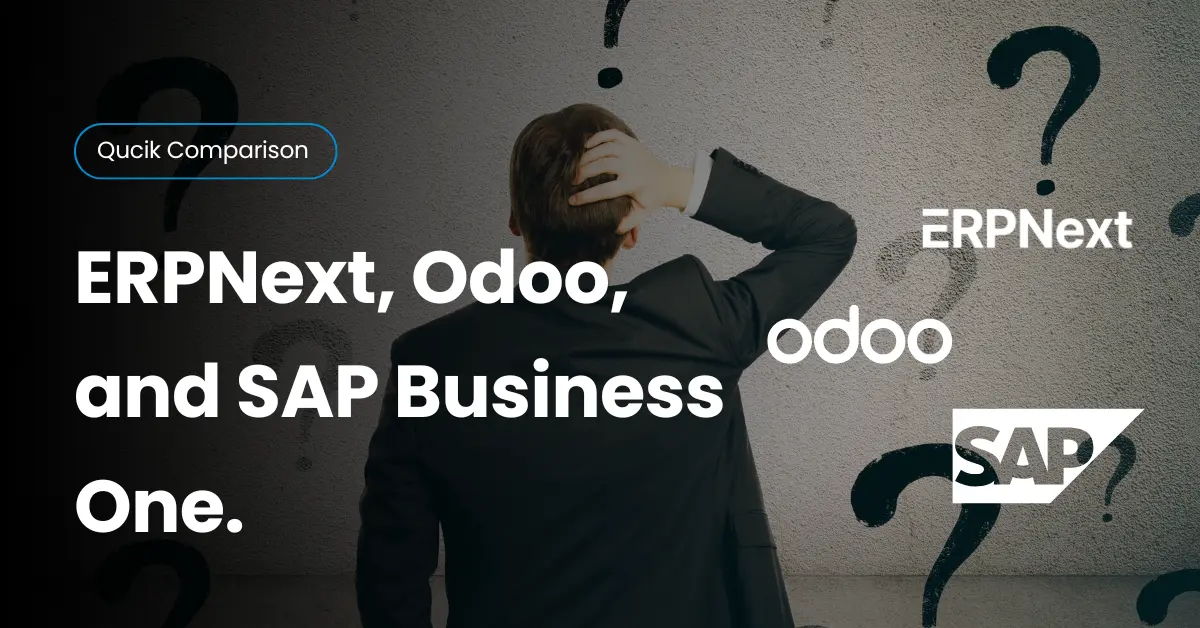Choosing the right ERP system is one of the most strategic decisions for any growing manufacturer. Between open-source platforms like ERPNext and Odoo, and enterprise-grade options like SAP Business One, the decision can shape your company’s agility, efficiency, and costs for years to come.
With dozens of ERP solutions available, the challenge isn’t finding software — it’s finding the right fit for your business model, scale, and goals. This comparison cuts through the noise to help U.S. manufacturers and mid-sized firms understand how these three systems differ in flexibility, pricing, and long-term value.
Why ERP Comparisons Matter for Mid-Sized Manufacturers
Many U.S. manufacturers outgrow spreadsheets, legacy systems, or standalone apps as operations scale. Disconnected tools make it hard to track inventory, manage production, and maintain real-time visibility — especially across multiple locations or supply chains.
That’s where a modern ERP solution becomes essential. It unifies accounting, manufacturing, CRM, and inventory into one system of record. But not all ERP platforms serve every business equally. For example, the needs of a food processor differ from those of a machinery manufacturer. Understanding the strengths of ERPNext, Odoo, and SAP Business One enables decision-makers to avoid costly mismatches and select a solution that supports long-term growth.
ERPNext Overview – Free, Flexible, and Built on Frappe
ERPNext is a free and open-source ERP designed for small to mid-sized manufacturers seeking flexibility without high licensing fees. Built on the Frappe Framework, it offers modular functionality covering Accounting, HR, Manufacturing, CRM, and Inventory Management — all in one browser-based platform.
Unlike many commercial ERPs, ERPNext’s Community Edition is free, backed by an active global community. That said, customization requires technical know-how. Businesses with in-house IT teams or trusted implementation partners often find it a cost-effective, scalable option. Here’s what ERPNext offers at a glance:
- Core modules: Accounting, HR, CRM, Manufacturing, Inventory
- Multi-company and multi-currency support
- Easy web-based deployment
- Integration with Google Workspace, Shopify, and Amazon
- Continuous updates through community support
Here’s the takeaway: ERPNext appeals to businesses seeking full control, transparency, and long-term affordability — especially those comfortable managing open-source platforms.
Odoo Overview – Modular, Modern, and Business-Friendly
Odoo combines the flexibility of open-source software with the polish of an enterprise platform. Available in Community and Enterprise Editions, it supports over 40 integrated apps, including CRM, Accounting, HR, Manufacturing, and eCommerce. Its modular design lets businesses start small and scale easily by adding new applications as they grow.
Odoo’s standout feature is its App Store, which offers thousands of extensions for niche business needs — from point-of-sale to marketing automation. The Enterprise version adds advanced features, faster performance, and official vendor support.
In practice, Odoo suits companies that want a balance of affordability, ease of use, and scalability. Its modern interface, global partner network, and cloud hosting options make it a strong contender for mid-sized manufacturers upgrading from outdated ERP systems.
SAP Business One Overview – Established, Enterprise-Grade, and Proprietary
SAP Business One Overview – Established, Enterprise-Grade, and Proprietary
SAP Business One is a proprietary ERP system designed for established and growing enterprises. Backed by SAP’s decades of enterprise experience, it offers comprehensive functionality — from finance and inventory to advanced analytics and reporting.
Unlike ERPNext and Odoo, SAP Business One isn’t open source. Its structured, vendor-supported model provides reliability and standardized processes but comes at a higher licensing and implementation cost.
For example, mid-sized distributors often choose SAP Business One when they need enterprise-level data control and integration with other SAP solutions. The trade-off? Less flexibility for customizations compared to open-source systems, but greater stability and long-term vendor assurance.
ERPNext vs Odoo vs SAP Business One: Detailed Comparison
When comparing these three ERP systems, the differences come down to scalability, cost, and ecosystem support. Each solution brings unique strengths that fit different business maturity levels.
Choosing the right ERP system is one of the most strategic decisions for any growing manufacturer. Between open-source platforms like ERPNext and Odoo, and enterprise-grade options like SAP Business One, the decision can shape your company’s agility, efficiency, and costs for years to come.
With dozens of ERP solutions available, the challenge isn’t finding software — it’s finding the right fit for your business model, scale, and goals. This comparison cuts through the noise to help U.S. manufacturers and mid-sized firms understand how these three systems differ in flexibility, pricing, and long-term value.
Why ERP Comparisons Matter for Mid-Sized Manufacturers
Many U.S. manufacturers outgrow spreadsheets, legacy systems, or standalone apps as operations scale. Disconnected tools make it hard to track inventory, manage production, and maintain real-time visibility — especially across multiple locations or supply chains.
That’s where a modern ERP solution becomes essential. It unifies accounting, manufacturing, CRM, and inventory into one system of record. But not all ERP platforms serve every business equally. For example, the needs of a food processor differ from those of a machinery manufacturer. Understanding the strengths of ERPNext, Odoo, and SAP Business One enables decision-makers to avoid costly mismatches and select a solution that supports long-term growth.
ERPNext Overview – Free, Flexible, and Built on Frappe
ERPNext is a free and open-source ERP designed for small to mid-sized manufacturers seeking flexibility without high licensing fees. Built on the Frappe Framework, it offers modular functionality covering Accounting, HR, Manufacturing, CRM, and Inventory Management — all in one browser-based platform.
Unlike many commercial ERPs, ERPNext’s Community Edition is free, backed by an active global community. That said, customization requires technical know-how. Businesses with in-house IT teams or trusted implementation partners often find it a cost-effective, scalable option. Here’s what ERPNext offers at a glance:
- Core modules: Accounting, HR, CRM, Manufacturing, Inventory
- Multi-company and multi-currency support
- Easy web-based deployment
- Integration with Google Workspace, Shopify, and Amazon
- Continuous updates through community support
Here’s the takeaway: ERPNext appeals to businesses seeking full control, transparency, and long-term affordability — especially those comfortable managing open-source platforms.
Odoo Overview – Modular, Modern, and Business-Friendly
Odoo combines the flexibility of open-source software with the polish of an enterprise platform. Available in Community and Enterprise Editions, it supports over 40 integrated apps, including CRM, Accounting, HR, Manufacturing, and eCommerce. Its modular design lets businesses start small and scale easily by adding new applications as they grow.
Odoo’s standout feature is its App Store, which offers thousands of extensions for niche business needs — from point-of-sale to marketing automation. The Enterprise version adds advanced features, faster performance, and official vendor support.
In practice, Odoo suits companies that want a balance of affordability, ease of use, and scalability. Its modern interface, global partner network, and cloud hosting options make it a strong contender for mid-sized manufacturers upgrading from outdated ERP systems.
SAP Business One Overview – Established, Enterprise-Grade, and Proprietary
SAP Business One Overview – Established, Enterprise-Grade, and Proprietary
SAP Business One is a proprietary ERP system designed for established and growing enterprises. Backed by SAP’s decades of enterprise experience, it offers comprehensive functionality — from finance and inventory to advanced analytics and reporting.
Unlike ERPNext and Odoo, SAP Business One isn’t open source. Its structured, vendor-supported model provides reliability and standardized processes but comes at a higher licensing and implementation cost.
For example, mid-sized distributors often choose SAP Business One when they need enterprise-level data control and integration with other SAP solutions. The trade-off? Less flexibility for customizations compared to open-source systems, but greater stability and long-term vendor assurance.
ERPNext vs Odoo vs SAP Business One: Detailed Comparison
When comparing these three ERP systems, the differences come down to scalability, cost, and ecosystem support. Each solution brings unique strengths that fit different business maturity levels.
| Feature / Criteria | ERPNext | Odoo | SAP Business One |
| License | Free & Open Source | Community (Free), Enterprise (Paid) | Proprietary |
| Scalability | Ideal for SMBs | SMBs to Mid-Enterprise | Strong Enterprise Scalability |
| Customization | High (Frappe Framework) | High (Odoo Studio) | Moderate |
| Support | Community-Driven | Global Partner Network | Vendor-Supported |
| Cost | Free + Hosting | Modular, User-Based Pricing | Premium License |
| Interface | Simple, Functional | Modern & Intuitive | Traditional |
| Deployment | Cloud / On-prem | Cloud / On-prem | Cloud / On-prem |

In practice, ERPNext offers unbeatable cost efficiency and flexibility for smaller firms. Odoo strikes the middle ground — modern, scalable, and user-friendly. SAP Business One remains the go-to for businesses that value vendor-backed reliability over deep customization.
Key Factors to Consider When Choosing Between Odoo, ERPNext, and SAP Business One
Selecting an ERP isn’t just about features — it’s about how well the system aligns with your operations, budget, and IT capabilities. Even a great ERP can underperform if it’s too complex or costly to maintain.
Consider these key factors:
- Implementation and setup complexity
- Integration needs (CRM, eCommerce, POS)
- Scalability for future growth
- Support and maintenance model
- Customization, flexibility and developer ecosystem
- Total cost of ownership over 3–5 years
Here’s the takeaway: ERPNext is best for teams with technical resources; Odoo fits companies that want easy customization and a clean UI; SAP Business One suits larger operations that prioritize structured vendor support.
Real-World Scenarios – Which ERP Fits Which Business Type?
Every ERP system serves a distinct niche. Below are examples to help visualize where each excels:
- ERPNext: A 100-employee electronics manufacturer wants low-cost flexibility with full manufacturing and inventory control. ERPNext’s open-source model makes it easy to modify workflows and add modules as the business grows.
- Odoo: A regional retail chain expands online and needs eCommerce, CRM, and accounting in one integrated solution. Odoo’s modular apps make scaling effortless.
- SAP Business One: A wholesale distributor requires deep analytics, multi-branch accounting, and robust vendor support. SAP Business One delivers reliability and enterprise-grade performance.
Here’s the insight: the “best” ERP depends less on popularity — and more on fit, scalability, and available support resources.
Partnering with Infintrix Technologies for ERP Implementation
Implementing the right ERP takes more than software — it takes expertise. Infintrix Technologies helps manufacturers and mid-sized businesses evaluate, deploy, and optimize ERP systems like ERPNext and Odoo.
Our consultants provide tailored guidance from system selection to post-launch support, ensuring each ERP implementation aligns with operational goals.
Core capabilities include:
- ERPNext and Odoo customization and hosting
- Module development (Accounting, Inventory, CRM, Manufacturing)
- Integration with e-commerce and cloud platforms
- ERP consulting for manufacturing, retail, and education industries
Here’s the takeaway: With Infintrix Technologies as your partner, ERP adoption becomes a strategic step — not a technical struggle.
Conclusion – Choosing the Right ERP Solution for Your Business
Each ERP platform — ERPNext, Odoo, and SAP Business One — serves a different business maturity level. ERPNext offers open-source flexibility, Odoo delivers modular scalability, and SAP Business One provides enterprise-grade assurance.
For most mid-sized U.S. manufacturers, the right ERP is the one that balances cost, usability, and scalability without locking the business into rigid systems.
Speak with Infintrix Technologies to evaluate the ERP system that fits your company’s goals, industry, and budget.
Frequently Asked Questions:
Q1: Which ERP is best for small manufacturers?
ERPNext typically suits small manufacturers due to its flexibility, free license, and strong community support.
Q2: How is Odoo’s Community Edition different from Enterprise?
The Community version is free but has limited modules; the Enterprise version includes advanced apps, cloud hosting, and official support.
Q3: Is SAP Business One worth the investment for mid-sized firms?
Yes — if the business needs vendor-backed reliability and standardized processes. However, the cost may be high for smaller operations.
Q4: Can Odoo or ERPNext integrate with eCommerce systems?
Both integrate with Shopify, WooCommerce, and Amazon, making them strong options for retailers expanding online.n, making them strong options for retailers expanding online.

